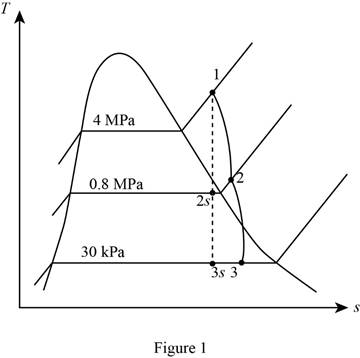
The power output produced from the turbine, and the overall isentropic efficiency of turbine.
Answer to Problem 197RP
The power output produced from the turbine is
The overall isentropic efficiency of turbine is
Explanation of Solution
Write the formula to calculate the specific entropy of steam from tables
Here, specific entropy of saturated liquid is
Write the formula to calculate the specific enthalpy of steam from tables
Here, specific entropy of saturated liquid is
Draw the

Write the formula for isentropic efficiency of the turbine
Here, specific enthalpy at the turbine inlet is
Write the formula for isentropic efficiency of the turbine
Here, specific enthalpy at the actual turbine exit is
Write the expression for the energy balance Equation for a closed system.
Here, net energy rate transfer into the control volume is
Write the general expression to calculate the isentropic efficiency of turbine
Here, actual work output is
Conclusion:
The rate of change in energy of the system is zero at steady state.
Substitute
Substitute
Re-write the Equation (VIII) for the isentropic work output
Here, mass flow rate of steam at inlet is
From the Table A-6 “Superheated water”, obtain the specific enthalpy
From the Table A-5 “Saturated water - Pressure”, obtain the following properties of water at pressure of
Substitute
Substitute
Equation (II).
Substitute 0.97 for
Equation (III).
Substitute
Substitute
From the Table A-5 “Saturated water - Pressure”, obtain the following properties of water at pressure of
Substitute
Substitute
Substitute
Substitute
Thus, the power output produced from the turbine is
Substitute
Substitute
Thus, the overall isentropic efficiency of turbine is
Want to see more full solutions like this?
Chapter 7 Solutions
CENGEL'S 9TH EDITION OF THERMODYNAMICS:
- Find the damping coefficient of system given below. Use k=20kN/m, c=100 N-s/m and m=10kg. 122222 Je 0.3 m 0.3 m 0.6m 0.0402 1 b 0.056 C 0.556arrow_forwardPLEASE SOLVE STEP BY STEP WITHOUT ARTIFICIAL INTELLIGENCE OR CHATGPT SOLVE BY HAND STEP BY STEParrow_forwardPLEASE SOLVE STEP BY STEP WITHOUT ARTIFICIAL INTELLIGENCE OR CHATGPT SOLVE BY HAND STEP BY STEParrow_forward
- PLEASE SOLVE STEP BY STEP WITHOUT ARTIFICIAL INTELLIGENCE OR CHATGPT SOLVE BY HAND STEP BY STEParrow_forwardConsider the bar, shown in Figure 1 that undergoes axial displacement due to both a distributed load and a point force. The bar is of cross-sectional area A = 1.10-3 m², and has a modulus of elasticity E = 100 GPa. 1(x) = 5 kN/m x=0.0 x=2.0 2.0m 10 kN Figure 1: Bar domain with varying distributed forces. a) The general form of the governing equations describing the bar's displacement, u(x), is given by, d (AE du(x)) -) +1(x) = 0. d.x dx What are the accompanying boundary conditions for this bar? b) Using the mesh in Figure 2, form the basis functions associated with element 2 and write the FEM approximation over the element. 1 2 3 1 2 1m 1m Figure 2: Mesh of 2 elements. Elements are numbered with underlines. c) The general form of the element stiffness matrix system, with nodes indexed by i and j, is, AE Uj N;(x)l(x)dx – Ng(0)f(0) ¥ [4]}]{{}}={{{}\(\\+} + {N(2)f(2) = N (0)5() }, (1) 0, respectively. L = (2) where f(2) and f(0) denote the boundary forces at positions x 2 and x Evaluate…arrow_forwardanswer pleasearrow_forward
- amination) Question 1 Consider the bar, shown in Figure 1, that undergoes axial displacement due to both a distributed load and a point force. The bar is of cross-sectional area A = 1.103 m2, and has a modulus of elasticity E = 100 GPa. 1(x) = 5 kN/m 10 kN X x=0.0 x=2.0 2.0m Figure 1: Bar domain with varying distributed forces. a) The general form of the governing equations describing the bar's displacement, u(x), is given by, d (AE du(x)) + 1(x) = 0. dx dx What are the accompanying boundary conditions for this bar? MacBook Air a 会 DII F5 F6 F7 F8 80 F3 F4 0/ 20 [8 marksl 8 FOarrow_forwardAnswer Barrow_forwardfem helpUsing the mesh in Figure 2, form the basis functions associated with element 2 and write the FEMapproximation over the element.arrow_forward
- Answer carrow_forwardshow workingarrow_forwardCFD help Figure 3: Advection equation, solution for three different timesteps. Q1) Provide an explanation what conditions and numerical setup could explain the curves. Identify which of the three curves is the first, second and third timestep.arrow_forward
 Elements Of ElectromagneticsMechanical EngineeringISBN:9780190698614Author:Sadiku, Matthew N. O.Publisher:Oxford University Press
Elements Of ElectromagneticsMechanical EngineeringISBN:9780190698614Author:Sadiku, Matthew N. O.Publisher:Oxford University Press Mechanics of Materials (10th Edition)Mechanical EngineeringISBN:9780134319650Author:Russell C. HibbelerPublisher:PEARSON
Mechanics of Materials (10th Edition)Mechanical EngineeringISBN:9780134319650Author:Russell C. HibbelerPublisher:PEARSON Thermodynamics: An Engineering ApproachMechanical EngineeringISBN:9781259822674Author:Yunus A. Cengel Dr., Michael A. BolesPublisher:McGraw-Hill Education
Thermodynamics: An Engineering ApproachMechanical EngineeringISBN:9781259822674Author:Yunus A. Cengel Dr., Michael A. BolesPublisher:McGraw-Hill Education Control Systems EngineeringMechanical EngineeringISBN:9781118170519Author:Norman S. NisePublisher:WILEY
Control Systems EngineeringMechanical EngineeringISBN:9781118170519Author:Norman S. NisePublisher:WILEY Mechanics of Materials (MindTap Course List)Mechanical EngineeringISBN:9781337093347Author:Barry J. Goodno, James M. GerePublisher:Cengage Learning
Mechanics of Materials (MindTap Course List)Mechanical EngineeringISBN:9781337093347Author:Barry J. Goodno, James M. GerePublisher:Cengage Learning Engineering Mechanics: StaticsMechanical EngineeringISBN:9781118807330Author:James L. Meriam, L. G. Kraige, J. N. BoltonPublisher:WILEY
Engineering Mechanics: StaticsMechanical EngineeringISBN:9781118807330Author:James L. Meriam, L. G. Kraige, J. N. BoltonPublisher:WILEY





